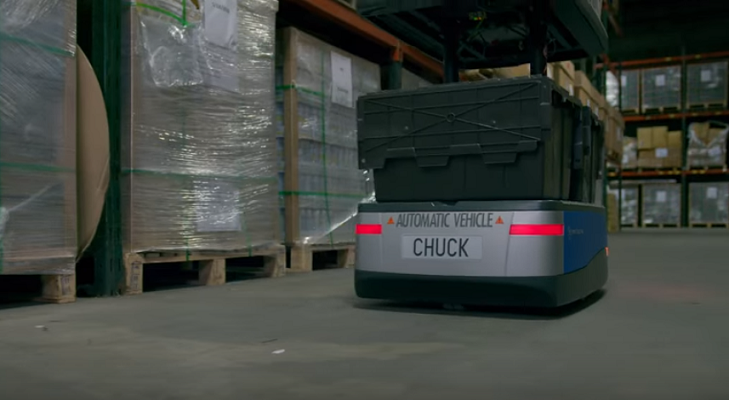By Rohma Abbas
, Content Marketing Manager, 6 River Systems
“The Magic Cart” got its beginnings at a company social earlier this summer. Fan Chen, one of our engineers and Solutions Designers, approached us with an idea for a creative video that would market our autonomous warehouse robot Chuck without actually showing Chuck. The Marketing team was only three-strong at the time, but we felt Fan was onto something. Sure, we had several videos about Chuck already on our YouTube channel, but none like the one Fan described. Could we do it?
Challenge accepted.
Why do this at all?
At 6 River Systems, we make robots and software that help warehouse associates do their jobs faster and better. We’ve built a warehouse automation solution that helps workers more accurately and efficiently complete tasks in the warehouse (like picking orders and replenishing inventory).
Our solution is a highly technical product with a range of benefits. But there are many warehouse robots out on the market claiming to make similar improvements. If you’re shopping for a robotic warehouse automation solution, it’s not easy to tell vendors apart at first glance. We needed a way to simplify our message and differentiate ourselves.
Inspiration from the field
Fan came to us with the concept, but we weren’t the first to attempt this. The title of our video is a nod to another creative concept video called “The Magic Shelf” by Kiva Systems, a warehouse robotics company that was acquired by Amazon in 2012.
What we really loved about this video was how the character, then-head of marketing Peter Blair, was relatable. He was a frustrated picker whose feet were killing him walking around the warehouse all day. Wasn’t there a better way to pick products? The concept was easy to grasp: what if there was a magic shelf, where products came to pickers?
Then, what if there was a “magic cart” that helped warehouse associates complete their tasks faster and better?
The challenge: What to focus on?
Our first script was long, and our first video draft came in at nearly five minutes. The original concept was a contest between two pickers in a warehouse. One picker works their route without Chuck, facing obstacles and slowdowns along the way. The other picker breezes through their work because they’ve got a secret helper: Chuck. The picker with Chuck wins the contest and earns a spot on the warehouse leaderboard.
We used our office camera, an intern’s help, and a few prop to create a dry run. But, there was something off with the concept (and certainly the execution). And it was way too long. Ideal video lengths across all platforms are 30 seconds to two minutes. No one was going to watch a five-minute video. So we solicited help from some experts.
Back to the drawing board
We were lucky to end up working with a video production crew that gave us critical feedback. They also thought the script was too long, and, the concept just felt “off.” The crew pitched another idea: what if we made Chuck human? He’d be dressed in a well-tailored suit but he’d wear blue “Chucks:” professional but fun.
Bingo.
Now, we needed to find actors.
A team effort
One of our core values as a company is “scrappy, yet thoughtful.” We had to decide early on if we were going to hire professional actors or use our own “talent” in-house. You can probably guess which way we went.
At the end of one Slack exchange, three stars were born. Greg Walls, one of our solutions executives who’s a fixture in our video marketing already; Ted Armstrong, a software engineer who at the time was new to the company but had acting experience; and me, the writer/ prop-getter extraordinaire with no experience on camera. We could’ve gone the professional route, but it was neat to represent three different departments of the company.
And…action!
We spent an entire day in a warehouse shooting scenes with a six-person camera crew. The result was hours and hours of footage that we condensed into a three-minute video. It still felt too long, so we cut it down even further, to a crisp 2:35 minutes.
Results and lessons learned
In two weeks, “The Magic Cart” got more than 16,000 views across LinkedIn, YouTube, and Facebook combined. The video also received some attention among our customers and was featured in an internal customer newsletter. We are still finding use cases for this video, and the promotion continues.
I learned a few things throughout this process:
1. Good marketing ideas live everywhere, not just in the marketing department. Remember, Fan from Solutions Design came to us with the initial idea. It’s because the culture of our company made it easy for him to pitch us ideas. It’s a draw of startup life: smaller teams work more closely together because they need to. In this case, it was a huge strength that seriously benefitted this project.
2. Shorter is always better. One of the most painful parts of this process was cutting out really good scenes for the sake of brevity. And yet, I don’t remember the last time I looked at a piece of marketing and said “This is too short.” Simplifying our messaging and cutting scenes made our video stronger overall, and more likely to be viewed
3. Be human. Literally. Our product is meant to help warehouse employees, not replace them. So initially, we hesitated at making Chuck “human” because we were concerned it would send the wrong message when human Chuck turns into robot Chuck. But looking back, the risk would have been not to do it. Personifying Chuck showed our audience that we work with humans, not against them. We help them be better.
Rohma Abbas is the Content Marketing Manager at 6 River Systems, where she markets a robot named Chuck. In her spare time, she blogs about corporate writing at Sprite Writing. Follow her work on LinkedIn and Twitter.








